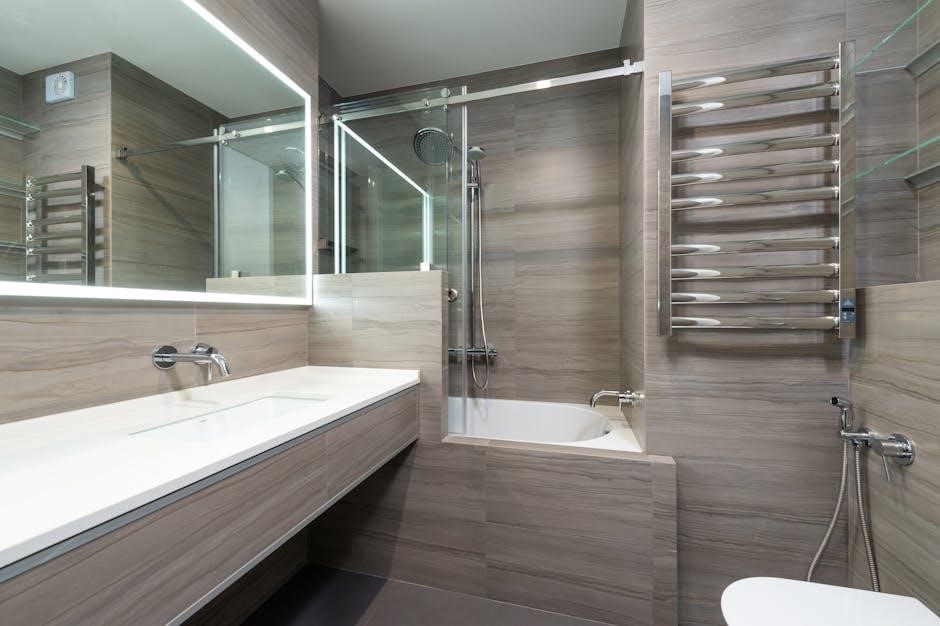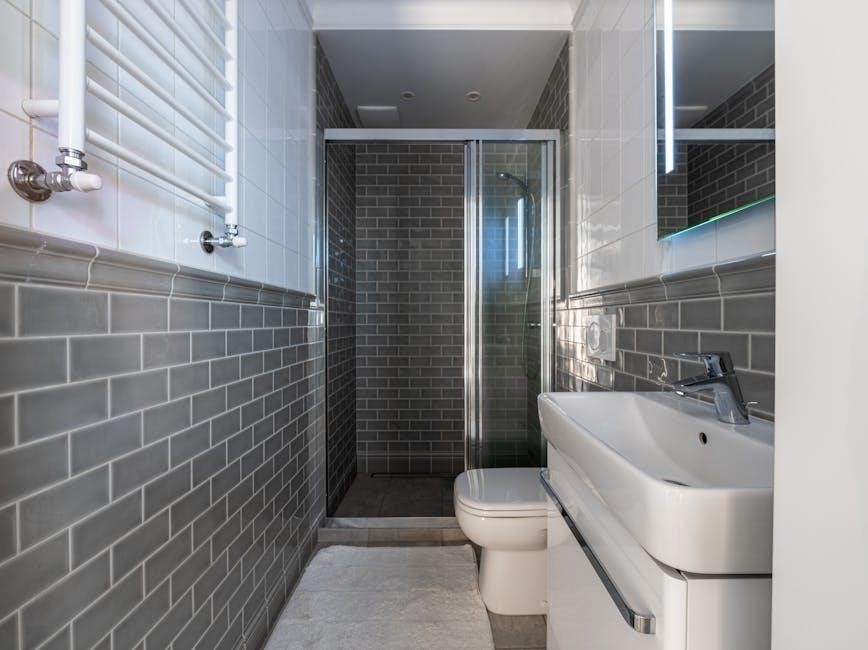A sliding shower door bottom guide with screw ensures proper door alignment and smooth operation, preventing misalignment and water leakage. Made from durable materials like plastic or acrylic, it is easy to install and maintain, providing long-lasting functionality for shower doors of various thicknesses. This essential component enhances stability and ensures a secure seal, making it a crucial part of modern shower door systems.
Overview of the Sliding Shower Door Bottom Guide
The sliding shower door bottom guide with screw is a critical component designed to keep shower doors aligned and functioning smoothly. Typically made from durable materials like plastic or acrylic, it features channels to accommodate various glass thicknesses. Easy to install with provided screws, it ensures proper door movement, prevents misalignment, and helps maintain a watertight seal, enhancing overall shower door performance and longevity.
Importance of the Bottom Guide in Shower Door Functionality
The bottom guide is essential for maintaining proper shower door alignment and smooth operation. It prevents the door from shifting or swinging, ensuring consistent functionality. By keeping the door securely in its track, it helps prevent water leakage and enhances stability. This component is vital for maintaining the longevity and performance of sliding shower doors, ensuring a reliable and watertight seal.
Design Features of the Sliding Shower Door Bottom Guide
The sliding shower door bottom guide features a robust construction with durable materials like plastic or acrylic. It includes adjustable alignment options and compatibility with various glass thicknesses, ensuring a secure fit and smooth door operation.
Construction Materials and Durability
The sliding shower door bottom guide is typically crafted from high-quality materials such as durable plastic or clear acrylic. These materials ensure longevity and resistance to water exposure, making them ideal for bathroom environments. The robust construction withstands frequent use and maintains alignment, while the sleek design complements modern shower aesthetics without compromising functionality or durability.
Channel Size and Compatibility with Glass Thickness
The sliding shower door bottom guide features a channel size of 1/2 inch, accommodating glass thickness up to 7/16 inch. This design ensures compatibility with various glass panels, providing a secure fit and proper alignment. The guide’s dimensions are standardized to work seamlessly with multiple manufacturers, ensuring smooth operation and preventing misalignment issues in shower door systems.
Adjustable and Fixed Options for Alignment
The sliding shower door bottom guide offers both adjustable and fixed options, providing flexibility for precise alignment. Adjustable guides allow for fine-tuning door positioning, ensuring smooth operation, while fixed guides offer stability and simplicity. These options cater to different installation needs, helping maintain proper door alignment and preventing operational issues in shower systems.

Installation Process of the Sliding Shower Door Bottom Guide
The installation involves attaching the guide to the shower door track using screws, ensuring proper alignment and leveling for smooth door operation. It requires basic tools and careful placement to secure the guide effectively, providing stability and functionality to the sliding shower door system.
Step-by-Step Guide for Proper Installation
Start by aligning the bottom guide with the shower door track, ensuring it fits securely. Use the provided screws to fasten it in place, tightening them gently to avoid stripping. Check the alignment by sliding the door back and forth. If necessary, adjust the guide slightly for proper movement and ensure it is level. Finally, test the door’s operation to confirm smooth functionality and stability.
Tools and Hardware Required for Installation
Essential tools include a screwdriver for securing the guide and a level to ensure proper alignment. Hardware typically includes screws provided with the guide. Additional items like a measuring tape or adjustable wrench may be useful for precise installation. Ensure all components are compatible with your shower door system for a secure and stable setup.
Tips for Ensuring Secure and Level Placement
Use a level to ensure the guide is perfectly aligned with the shower door track. Mark screw holes accurately and pre-drill if necessary. Tighten screws firmly but avoid over-tightening to prevent damage. Check door movement post-installation to ensure smooth operation. Ensure the guide is flush with the track for optimal stability and alignment, and verify all components are securely fastened.
Maintenance and Adjustment of the Bottom Guide
Regularly clean the guide with mild detergent to prevent debris buildup. Lubricate moving parts with silicone spray for smooth operation. Adjust screws as needed to maintain proper door alignment.
Cleaning and Lubricating the Guide for Smooth Operation
Regular cleaning with mild detergent and water prevents debris buildup. Dry thoroughly after cleaning. Apply silicone-based lubricant to moving parts to ensure smooth operation. Avoid harsh chemicals that may damage materials. Regular maintenance extends the guide’s lifespan and keeps the shower door functioning smoothly.
Adjusting the Guide to Align the Shower Door Properly
To align the shower door, locate the adjustment screws on the bottom guide. Loosen them slightly to allow movement. Gently lift or lower the door to achieve proper alignment with the track. Tighten the screws once aligned. Regular adjustments ensure smooth operation and prevent misalignment issues. Proper alignment also helps prevent water leakage and enhances overall door stability.
Inspecting for Wear and Tear Over Time
Regularly inspect the bottom guide for signs of wear, such as cracks or discoloration, which can indicate material degradation. Check the screws for tightness and ensure proper alignment with the shower door track. Over time, plastic or acrylic guides may show signs of aging, such as brittleness or loosening. Addressing these issues promptly helps maintain door stability and prevents water leakage.

Troubleshooting Common Issues
Troubleshooting common issues with sliding shower door bottom guides involves addressing misalignment, water leakage, and sticking doors. Adjusting screws, cleaning debris, and ensuring proper alignment are key solutions. Replacing worn-out parts can prevent further damage and maintain smooth operation.
Addressing Misalignment of the Shower Door
Misalignment can be resolved by loosening the adjustment screws on the bottom guide, allowing the door to move freely. Clean debris from the track and ensure the guide is properly aligned. If issues persist, check for worn-out parts and replace them to restore smooth operation and prevent further misalignment.
Fixing Leaks Related to the Bottom Guide
Leaks often occur due to misalignment or improper sealing. To fix, ensure the bottom guide is securely fastened and properly aligned. Loosen adjustment screws, realign the door, and tighten them. Clean debris from the track and guide to ensure a watertight seal. If leaks persist, inspect and replace worn-out seals or adjust the door sweep to prevent water seepage.
Dealing with Sticking or Difficult Door Movement
Sticking doors often result from debris or misalignment. Clean the bottom guide and track thoroughly, removing any dirt or soap buildup. Apply a silicone-based lubricant to the guide and rollers for smooth operation. If the issue persists, check for proper alignment and adjust the screws on the bottom guide to ensure the door glides freely without obstruction or difficulty.
When to Replace the Sliding Shower Door Bottom Guide
Replace the bottom guide if it shows visible wear, cracks, or breaks, or if it no longer aligns the door properly, causing sticking or water leakage issues.
Signs of Damage or Wear Requiring Replacement
Signs of damage or wear include visible cracks, breaks, or excessive wear on the guide. If the door misaligns, sticks, or leaks water, it may indicate the guide needs replacement. Over time, wear can cause instability, making the door difficult to operate smoothly, signaling the need for a new bottom guide to restore proper functionality and prevent further issues.
Upgrading to a Better Quality or Design
Upgrading to a higher-quality or improved design enhances functionality and durability. Premium materials like clear acrylic or nylon offer better resistance to wear and corrosion. Adjustable guides provide easier alignment, while sleek designs complement modern aesthetics. Upgrading ensures smoother door operation, improved stability, and a more polished look, making it a worthwhile investment for long-term performance and style.
Replacing the Guide for Aesthetic Reasons
Replacing the bottom guide for aesthetic reasons allows you to match your bathroom’s style. Choose from various colors like white, black, or clear acrylic to complement your decor. Modern designs and materials, such as sleek plastic or nylon, can enhance the overall appearance of your shower door. This simple upgrade refreshes the look without major renovations.
Choosing the Right Sliding Shower Door Bottom Guide
Consider material durability, compatibility with your door’s thickness, and ease of installation. Select guides made from sturdy plastics or acrylics for long-lasting performance and aesthetic appeal.
Factors to Consider for Material and Size
Choose durable materials like plastic, acrylic, or nylon for water resistance. Ensure the guide’s channel size matches your shower door’s thickness (e.g., 1/4″ or 3/8″). Measure accurately to guarantee proper fit and smooth operation. Opt for guides with screws for easy installation and adjustment, ensuring compatibility with framed or frameless doors.
Compatibility with Existing Shower Door Systems
Ensure the bottom guide aligns with your shower door’s type, whether framed, frameless, or top-hung. Verify the channel size matches the door’s thickness (e.g., 1/4″ or 3/8″) for proper fit. Select guides made from durable materials like plastic or acrylic, designed for water resistance. Check compatibility with existing tracks and hardware to avoid installation issues, ensuring smooth operation and long-term functionality.
Reading Reviews and Product Ratings for Informed Decisions
Reading reviews and checking product ratings helps identify reliable and durable bottom guides. Highly-rated options like the PalpitateC M6219 and Prime-Line guides are praised for their easy installation and durability. Customers often highlight features like compatibility with various glass thicknesses and secure alignment. Reviewing feedback ensures you select a guide that meets your specific needs and enhances shower door functionality effectively.

Security and Stability Provided by the Bottom Guide
The sliding shower door bottom guide ensures stability by preventing door shifting, maintaining alignment, and providing a secure seal to prevent water leakage effectively during use.
Preventing Door Shifting or Sliding Accidentally
The bottom guide acts as a physical barrier, ensuring the shower door stays securely in place. Its sturdy design prevents accidental sliding, keeping the door aligned and stable. Made from durable materials like plastic or acrylic, it withstands daily use, while its secure installation with screws minimizes the risk of door shifting, enhancing safety and preventing water leakage.
Ensuring a Secure Seal to Prevent Water Leakage
The bottom guide ensures a secure seal by aligning the shower door properly within its track, preventing gaps where water could leak. Its snug fit and durable construction keep the door stable, while the screw-based installation enhances tightness. This design effectively prevents water from seeping through, maintaining a waterproof seal and protecting the bathroom floor from moisture damage.
Enhancing the Overall Stability of the Shower Door
The bottom guide enhances stability by securely aligning the shower door within its track, preventing wobbling or unintended movement. Constructed from durable materials like plastic or acrylic, it provides a sturdy base that maintains door position, ensuring smooth operation and preventing accidental shifts. This stability not only improves functionality but also adds safety, making the shower door more reliable and secure for daily use.

Comparison with Other Shower Door Guides
The sliding shower door bottom guide with screw offers superior alignment and stability compared to roller or hinged guides, ensuring smoother operation and preventing door misalignment or leakage issues.
Differences Between Bottom and Top Guides
The bottom guide is screwed to the track, providing alignment and stability for frameless sliding shower doors, while top guides use rollers and are part of the door’s upper track system. Bottom guides are designed to fit specific glass thicknesses, often made of plastic or acrylic, and are essential for preventing water leakage. In contrast, top guides focus on smooth gliding and reducing friction, making them less involved in water sealing but crucial for door movement. Both guides work together to ensure proper door function, but their designs and roles differ significantly in application and purpose.
Advantages Over Roller or Hinged Guides
The sliding shower door bottom guide with screw offers enhanced stability and alignment compared to roller or hinged systems. It prevents door shifting and water leakage, ensuring a secure seal. Unlike rollers, which can wear out, the bottom guide provides consistent performance. Its simple design makes installation and maintenance easier, while its durability ensures long-lasting functionality for frameless shower doors.
Cost and Value Comparison with Alternative Options
The sliding shower door bottom guide with screw is a cost-effective solution compared to roller or hinged systems. Priced between $10 to $15, it offers durability and ease of installation, making it a budget-friendly option. Alternative guides, like rollers, may cost more and require complex adjustments, while this bottom guide ensures long-term value with minimal maintenance and reliable performance.
The sliding shower door bottom guide with screw is a simple yet essential component, ensuring smooth door operation, alignment, and water tightness. Its durability and ease of installation make it a practical solution for maintaining shower door functionality and longevity.
Final Thoughts on the Importance of the Bottom Guide
The sliding shower door bottom guide with screw is an essential component, ensuring proper alignment, smooth operation, and water tightness. Its durable construction and easy installation make it a vital part of maintaining shower door functionality and longevity, preventing issues like misalignment and leakage while enhancing overall stability and user satisfaction.
Encouraging Proper Maintenance for Longevity
Regular cleaning and lubrication of the sliding shower door bottom guide ensure smooth operation and prevent wear. Remove soap scum and mildew with a mild detergent, and apply silicone spray to moving parts. Inspect for alignment issues and tighten screws as needed to maintain stability and prevent leaks. Proper care extends the guide’s lifespan and keeps the shower door functioning optimally.
